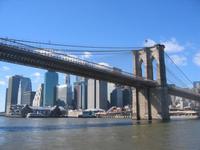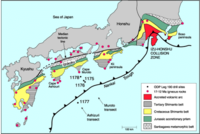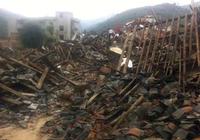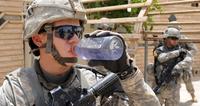-
NYC bridges need better protection against terrorists: Experts

New York City’s bridges have long been the target of terrorist attacks. In 1993, for example, officials discovered a plot by Omar Abdel-Rahman to target the George Washington Bridge and other sites. Recent security breaches on both the Brooklyn Bridge and Manhattan Bridge have heightened concerns as the anniversary of the 9/11 attacks near. Mayor Bill de Blasio has said that his office would soon offer better ways to secure the Brooklyn Bridge.
-
-
No Fukushima radiation found in California’s coastal areas
Following the 11 March 2011 Fukushima disaster, researches wanted to see whether radioactivity could be found in Bay Area precipitation. They collected weeks’ worth of rainwater around UC Berkeley Campus to find out. The results: low levels of a number of different radioactive nuclei produced by the fission of uranium-235 including, cesium-134, cesium-137, and iodine-131. “The levels we saw were detectable, but low and not a health hazard to anyone,” said UC Berkeley’s nuclear engineering professor Eric Norman.
-
-
Japan boasts an earthquake early-warning system, but critics question its value

Since 1979, scientists with the Japanese earthquake prediction program have been monitoring a stretch of coastline southwest of Tokyo, watching for ground motion which might signal a pending rupture on the nearby fault zone. If motion is detected, Japanese law requires the prime minister to issue an emergency warning to close schools, secure hospitals, and shut down critical public transportation systems. Critics argue Japan will be unable to predict earthquakes in the same manner meteorologists track approaching typhoons or rain storms, saying that the program offers false hope.
-
-
ShakeAlert’s performance during August Napa tremor should lead to regional deployment: Supporters
Before the magnitude-6 earthquake struck Napa County late August, the Bay Area Rapid Transit received an alert ordering trains to stop, and some 911 operators had a few seconds of warning to brace for an influx of calls from concerned residents. The success of ShakeAlert, California’s earthquake early-warning system currently in the testing phase, has encouraged state lawmakers to push for funding — and deploying — the regional early warning system.
-
-
New Orleans creates economic value out of environmental vulnerability
Following the devastation of Hurricane Katrina in 2005, New Orleans and the state of Louisiana have become so adept at dealing with disaster reconstruction, that their new-found skills are now seen as an economic asset to be shared, for profit, with other states and localities. The area’s new environmental awareness is also a source of economic growth, as analysts now consider “emerging environmental” as one of six key industries in the city and state to focus on development, along with coastal restoration and water management, disaster mitigation and management, hazardous waste disposal, advanced bio fuels and waste water treatment.
-
-
American cities leading on climate change preparedness
Many mid-size American cities are becoming the most innovative responders when it comes to creating infrastructure which is ready for the consequences of climate change on the scale predicted by scientists. With these scientific predictions in mind, and citing deadly and costly “super storms” such as Sandy in 2012 — which killed 130 people, destroyed 650,000 homes, and left 8.5 million people without power —cities have not only looked to rebuild following such natural disasters, but also to create “resiliency” within their infrastructure and communities.
-
-
Experts defend operational earthquake forecasting

After the devastating 2009 L’Aquila earthquake in Italy, critics suggested that operational earthquake forecasting (OEF) is ineffective, distracting, and dangerous. In an editorial published in the Seismological Research Letters, experts defend OEF, arguing the importance of public communication as part of a suite of activities intended to improve public safety and mitigate damage from earthquakes.
-
-
Improving earthquake early warning systems, data collection
Researchers are working on what will be the U.S. first earthquake early warning system available to the public. Once fully implemented, the system will use networks of seismic instrumentation to detect when an earthquake is pending and send alerts via text message or other mass notification systems to people. The researchers are also workingon the Quake-Catcher Network to improve monitoring of earthquake activity around the world. Officials and city planners can use the data provided by Quake-Catcher to help decide where to build critical infrastructure such as power plants, hospitals, and water lines.
-
-
Developing portable water purifying device for the U.S. military

Providing a reliable source of purified drinking water for the U.S. soldiers in the field is the focus of a research grant at the Texas A&M Health Science Center School of Public Health. The research aims to develop a portable water treatment device which uses naturally occurring iron in the environment. Researchers say this iron is easily converted to an environmentally friendly chemical compound called ferrate that can be used as a water treatment disinfectant to purify water.
-
-
Los Angeles thinking of ways to shore up aging infrastructure
Los Angeles, the second-largest city in the nation by population size, has been dealing with crumbling infrastructure for years now. More than 10 percent of the city’s 7,200 miles of water pipes were built ninety years ago. About 40 percent of the region’s 6,500 miles of roads and highways are graded D or F, requiring so much money to fix them that the city is simply concentrating its maintenance efforts on C-graded roads, since they cost less to fix. Additionally, more than 4,000 of the 10,750 miles of sidewalks seriously need repair, according to city officials.
-
-
U.S. municipal data centers prepare to cope with sea-level rise
The National Academy of Sciences says that 316 coastal cities in the United States are expected to be affected by sea-level rise within the next few decades. Those responsible for infrastructure maintenance are now considering how they can be better prepared for this eventuality. Among their tasks is the protection of data centers which handle much of the world’s information.
-
-
Napa earthquake may persuade lawmakers to fund earthquake warning system
Last Sunday’s Napa earthquake may push Congress to increase funding for an earthquake warning system. Building out the West Coast earthquake warning system, called ShakeAlert, would cost $120 million over five years, and an additional $16 million a year to operate. Today, ShakeAlert operates in a testing phase, and sensors notify researchers and volunteer participants when an earthquake has been detected.
-
-
Seismic retrofitting of older buildings helps, but it has its limits
Even before last Sunday’s magnitude-6 earthquake struck Napa, officials anticipated that such an event would damage many of Napa’s historic brick buildings. So years ago, brick structures were required to get seismic retrofitting — bolting brick walls to ceilings and floors to make them stronger. “We can’t keep every single brick in place in many of these older buildings without extraordinarily costly retrofits,” says a structural engineer. “We can reduce the damage in losses, but not eliminate them entirely in older buildings.”
-
-
Better solutions for recycle fracking water
Scientists have performed a detailed analysis of water produced by hydraulic fracturing (aka fracking) of three gas reservoirs and suggested environmentally friendly remedies are needed to treat and reuse it. More advanced recycling rather than disposal of “produced” water pumped back out of wells could calm fears of accidental spillage and save millions of gallons of fresh water a year.
-
-
Investigating potential influences on recent U.K. winter floods
A comprehensive review of all potential factors behind the 2013-14 U.K. winter floods does not definitively answer whether human activity played a role in the magnitude of the winter flood events. It does, though, examine how factors such as the state of the global oceans may have interacted with wind patterns and subsequent high-level atmospheric features.
-
More headlines
The long view
Falling Space Debris: How High Is the Risk I'll Get Hit?
An International Space Station battery fell back to Earth and, luckily, splashed down harmlessly in the Atlantic. Should we have worried? Space debris reenters our atmosphere every week.
Using Drone Swarms to Fight Forest Fires
Forest fires are becoming increasingly catastrophic across the world, accelerated by climate change. Researchers are using multiple swarms of drones to tackle natural disasters like forest fires.
Strengthening the Grid’s ‘Backbone’ with Hydropower
Argonne-led studies investigate how hydropower could help add more clean energy to the grid, how it generates value as grids add more renewable energy, and how liner technology can improve hydropower efficiency.
LNG Exports Have Had No Impact on Domestic Energy Costs: Analysis
U.S. liquified natural gas (LNG) exports have not had any sustained and significant direct impact on U.S. natural gas prices and have, in fact, spurred production and productivity gains, which contribute to downward pressure on domestic prices.
